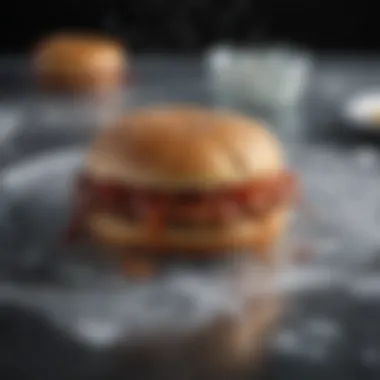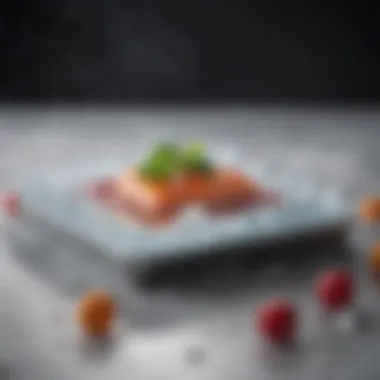Proper Thawing Procedure for Frozen Food Safety


Intro
Thawing frozen food is often overlooked, yet it plays a critical role in meal preparation. Understanding the correct procedures not only maintains the quality of the food but also ensures safety during cooking. Improper thawing can lead to foodborne illnesses, causing harm to health. The right methods will preserve flavors and textures, resulting in satisfying meals. This article aims to elucidate these thawing procedures, discuss various techniques, and provide necessary guidelines to optimize cooking practices.
Dangerous bacteria can proliferate when food is left at room temperature for extended periods. Therefore, mastering safe thawing practices is essential for anyone involved in cooking at home or professionally. The information presented here will arm you with knowledge to thaw food correctly, minimizing risks and maximizing taste. In the sections that follow, you will find detailed insights into thawing methods tailored to different food types and the science behind those practices.
Prelude to Frozen Food Thawing
Thawing frozen food correctly is an often overlooked step, yet it plays a crucial role in meal preparation. When food is frozen, the process preserves its freshness and nutritional value. However, improper thawing can negate these benefits and lead to food safety hazards. This section delves into the importance of understanding proper thawing procedures, discussing specific elements that every cook should be aware of when handling frozen food.
Understanding Frozen Food
Frozen food refers to any food product that has been preserved by lowering its temperature below freezing point. This is done to extend shelf life and maintain quality. When meats, vegetables, fruits, or prepared meals are frozen, their cellular structure temporarily changes. Proper thawing is essential as it allows the food to return to its original texture and taste. A sound understanding of how freezing and thawing affect food can greatly enhance cooking results. Moreover, it ensures that flavors and textures remain intact.
Why Proper Thawing Matters
Proper thawing is critical for several reasons:
- Food Safety: Thawing methods that involve leaving food at room temperature can create an environment conducive to bacterial growth.
- Quality Preservation: The right thawing technique helps maintain the desired texture. Some foods become mushy if thawed incorrectly, losing their appeal.
- Health Considerations: Improper thawing can lead to foodborne illnesses. Awareness of safe practices minimizes this risk.
Proper thawing is not just about convenience; it is a fundamental step in food preparation and safety.
Understanding the basis of safe thawing procedures ensures cooking enthusiasts can fully enjoy their meals without compromising quality or safety.
Food Safety Standards
Food safety standards are crucial when it comes to the thawing of frozen foods. Proper adherence to these guidelines greatly reduces the risk of foodborne illnesses and ensures the safety and quality of the food we consume. These standards are not just suggestions; they are established protocols based on scientific research and health regulations.
Understanding the importance of food safety standards helps individuals maintain a safe environment in the kitchen. This is especially relevant when thawing, as improper methods can lead to dangerous bacterial growth. By following these standards, cooks can avoid cross-contamination and control the temperatures at which food is stored and thawed.
The Danger Zone Explained
The term "danger zone" refers to the temperature range from 40°F to 140°F (4°C to 60°C), where bacteria multiply rapidly. When food is thawed in this range, it can escalate the risk for food safety significantly. The Centers for Disease Control and Prevention (CDC) states that food left within the danger zone for too long can become unsafe to eat.
To maintain safety, it is recommended to keep food out of the danger zone as much as possible. When thawing food, it should ideally be done in the refrigerator or through cold water methods. To further ensure safety:
- Monitor the temperature during thawing.
- Use a food thermometer to check internal temperatures.
- Always move food out of the danger zone as soon as thawing is complete.
Preventing Bacterial Growth
Preventing bacterial growth is a fundamental principle in food safety. When thawing frozen foods, it is essential to choose methods that restrict bacteria from multiplying. Here are some strategies:
- Refrigerator Thawing: This is the safest method. It allows food to thaw at a controlled temperature, well below the danger zone. While it may require extra time, it ensures that meat and poultry remain safe throughout the process.
- Cold Water Thawing: If quicker thawing is necessary, submerging the food in cold water is an effective choice. This method should involve sealing the food in a waterproof package. The change of water every 30 minutes helps maintain a low temperature.
Proper food handling is essential to prevent foodborne illness. Thaw safely to protect your health.
- Cooking from Frozen: Some foods can be cooked directly from frozen. However, cooking times will be longer, and care must be taken to ensure that the food reaches safe internal temperatures.
By integrating these methods, the risks associated with thawing frozen food can be significantly reduced. Cooking must always be approached with caution to minimize any health risks associated with bacteria.


Thawing Techniques Overview
Thawing frozen food correctly is integral to food preparation. The methods used to thaw can significantly impact both safety and quality of the food. Poor thawing practices can lead to the growth of harmful bacteria, while optimal techniques help retain food texture and nutrients. This section will cover the primary methods for thawing food, including their specific benefits and considerations. To preserve taste and avoid potential health hazards, understanding these techniques is crucial for any cooking enthusiast.
Refrigerator Thawing
Process and Duration
Refrigerator thawing is a method that uses low temperatures to slowly bring frozen food to a safe temperature. The process typically involves placing the food in its packaging on a plate or bowl to catch any juices that may leak during thawing. Depending on the size and type of food, this method can take several hours to a full day.
A key characteristic of refrigerator thawing is its gradual nature. This is beneficial because it keeps the food at a safe temperature, preventing bacterial growth. However, it requires foresight, as the duration can be lengthy. Large items, like whole turkeys, may require up to 24 hours for every five pounds to thaw adequately, making planning essential. In this way, refrigerator thawing aids in quality preservation as well, as the slower thawing process helps maintain texture.
Benefits of Refrigerator Thawing
The primary benefit of refrigerator thawing is its safety. By thawing food at cold temperatures, the risk of entering the temperature danger zone is minimized. For cooks, this is reassuring, as it reduces the chances of foodborne illness.
Another advantage is the convenience it offers for meal planning. With careful management, cooks can conveniently thaw foods in advance, ensuring that meals can be prepared efficiently. This method also prevents freezer burn, which can negatively affect food quality, particularly in meats.
Cold Water Thawing
Step-by-Step Guide
Cold water thawing is a quicker alternative to refrigerator thawing. It requires sealing the food in a leak-proof bag to prevent water from entering and to keep it from contaminating other foods. The bag is then submerged in cold water, changing the water every 30 minutes to ensure that it remains cold. This technique is typically faster than refrigerator thawing and is suitable for small packages of food.
A key aspect of this technique is its efficiency, which appeals to cooks needing food thawed promptly. However, it is less forgiving than refrigerator thawing, as it requires more active management. The unique feature here is the time savings it provides; smaller items can thaw within an hour or so, making it a popular choice when timely meal preparation is needed.
Considerations for Cold Water Thawing
One important consideration with cold water thawing is food safety. If the water becomes too warm, it can lead to bacterial growth. Therefore, it is crucial to monitor the water temperature and change it regularly. Although this method is generally safe, if not managed well, it could compromise food safety.
Additionally, this technique is not advisable for large cuts of meat or whole items, as they will not thaw uniformly and could remain frozen in the center, leading to cooking inconsistencies. Careful thought needs to go into deciding whether to use this approach for each specific food item.
Microwave Thawing
Microwave Efficiency
Microwave thawing involves using the defrost setting of the microwave and can rapidly thaw food. The efficiency of this method is appealing, especially for those short on time. This technique allows for thawing of individual portions or smaller packages effectively in mere minutes.
However, micowaves may not heat food evenly, leading to partially cooked areas. This irregular heating can cause issues if the food is not cooked immediately after thawing. Thus, understanding how to use the microwave correctly is key. This method is considered efficient, but the potential for uneven thawing requires caution in its application.
Safety Precautions
When using microwave thawing, certain safety precautions should be followed. For instance, food should be cooked right after thawing, as some parts may begin cooking and create an environment favorable for bacteria.
Additionally, using a microwave-safe container is vital to avoid chemical leaching from plastics. Therefore, while this method is quick, it demands careful attention to ensure that food safety is not compromised.
Cooking Without Thawing
Suitable Foods


Some foods can be cooked directly from frozen, which simplifies meal preparation. Items such as frozen vegetables, certain fish fillets, and pre-cooked meals can be introduced into cooking processes without thawing. The main advantage is time savings, allowing for a quick transition from freezer to table.
Also, cooking from frozen can help retain moisture and yield tender results in many cases.
Cooking Time Adjustments
Cooking directly from frozen typically necessitates longer cooking times. For meats, the general rule is to add about 50% more time compared to thawed products. This adjustment is crucial to ensure complete cooking and safety. Thus, understanding and planning for these time adjustments are essential for successful meal preparation, preventing potential food safety concerns.
Thawing Specific Food Types
Thawing specific food types is crucial for maintaining food safety and quality. Each type of food has distinct characteristics and requirements that dictate the best thawing methods. Understanding these differences enhances efficiency while cooking and ensures that flavors and textures remain intact. Moreover, it helps prevent foodborne illnesses, which is a regardable concern when handling raw products.
Meat and Poultry
Best Practices for Thawing
Best practices for thawing meat and poultry emphasize the importance of maintaining a safe temperature. The most reliable method is thawing in the refrigerator. This practice allows consistent temperature control, which minimizes the risk of bacterial growth. When meat is thawed gradually in cold conditions, its texture does not suffer, maintaining juiciness and flavor. Another popular method is using the cold water technique, which involves submerging meat in a sealed bag in cold water. This method is faster but requires careful monitoring to ensure the water stays cold. A unique feature of these best practices is that they prioritize food safety while simultaneously preserving quality.
Cooking Recommendations
Cooking recommendations for thawed meat and poultry focus on the importance of cooking these products immediately after thawing or keeping them in the refrigerator for no more than 1-2 days. This guideline ensures that quality is at its peak when cooked. Furthermore, it is wise to use a meat thermometer to check for doneness, as different cuts require varying cooking times. This practice not only ensures the meat is safe for consumption but also aids in achieving the desired tenderness and flavor. A distinct advantage of following these recommendations is the assurance that your meals will be both safe and pleasing to the palate.
Seafood
Thawing Techniques for Seafood
Thawing techniques for seafood are essential due to the delicate nature of this food category. The refrigerator method remains the safest choice since it gradually thaws fish without compromising texture. On the other hand, cold water thawing is acceptable but must be done with care to avoid rapid temperature changes. Seafood, especially fish, can lose moisture quickly during improper thawing, leading to a mushy texture. Utilizing the refrigerator method guarantees not just safety, but also quality, making it the most advantageous choice in this context.
Fish and Shellfish Guidelines
Fish and shellfish guidelines stress the importance of treating different seafood types according to their textures and cooking requirements. For example, fatty fish like salmon can tolerate slightly different handling compared to leaner species like cod. When thawing shellfish such as shrimp, it is important to ensure proper cleaning after thawing to remove any contaminants. These guidelines help in not only preserving flavor but also ensuring that the seafood retains its intended texture and nutritional value. Following these will give confidence in serving high-quality seafood dishes.
Fruits and Vegetables
Best Methods for Thawing
Best methods for thawing fruits and vegetables involve using cold water or refrigerator methods primarily. These techniques prevent oxidative damage and help retain color and nutrients. Unlike meat, vegetables may lose some texture when thawed improperly, hence gentle methods are preferred. The advantage of these methods lies in their ability to prevent the loss of vitamins and minerals, crucial for maintaining the nutritional profile of these foods.
Impact on Texture and Nutrients
Impact on texture and nutrients is significant when thawing fruits and vegetables. Frozen fruits often become mushy if not handled properly, while vegetables might lose their crispness. Fast thawing can also lead to nutrient loss due to leaching. Therefore, allowing them to thaw slowly prevents these changes and helps retain a nutritional edge in meals. Understanding these impacts aids cooks in maximizing the health benefits of their dishes.
Prepared Meals and Leftovers
Thawing Ready-to-Eat Foods
Thawing ready-to-eat foods involves ensuring that the meal will be suitable for consumption after reheating. The best practice is to thaw in the refrigerator, as it prevents bacteria from proliferating. Some individuals might prefer microwave thawing for quick results, yet caution must be exercised to avoid uneven thawing. The focus here is on ensuring safety while also preserving the food's original flavor and texture.
Safe Reheating Practices


Safe reheating practices are essential to avoid foodborne illnesses. It is crucial to reheat these meals to a safe internal temperature of at least 165°F (74°C) to ensure that any potential bacteria are eliminated. Using a food thermometer helps in achieving this goal accurately. Moreover, it is wise to reheat only the amount needed and avoid reheating multiple times. This approach enhances both safety and quality. It prevents the food from becoming dry or overcooked, maintaining the overall appeal once served.
Following proper thawing techniques is vital in ensuring food safety, nutritional quality, and optimal culinary experiences.
By understanding specific thawing needs for each food type, one can significantly reduce risks and create delicious meals without compromise.
This section emphasizes the importance of knowing how to thaw specific types of food while considering convenience, safety, and quality.
Common Thawing Mistakes
Understanding common thawing mistakes is crucial to ensuring food safety and quality. Many home cooks overlook the importance of proper thawing methods, which can lead to foodborne illnesses. Making mistakes in the thawing process can compromise not just the safety of the food but also its texture and flavor. This section will identify typical thawing errors and provide guidance on how to avoid them.
Thawing at Room Temperature
Thawing at room temperature is a method many might consider convenient. However, this technique poses significant risks. When food is left out, it can enter the "danger zone," temperatures between 40°F and 140°F, where bacteria can grow rapidly. A key characteristic of this method is that it gives bacteria a chance to multiply, putting diners at risk of food poisoning.
Risks Involved
The primary risk of thawing food at room temperature is bacterial growth. When food thaws unevenly, outer portions may reach temperatures conducive to bacterial proliferation while the interior remains frozen. This uneven thawing can lead to various harmful microorganisms developing unchecked. Moreover, this method often goes unnoticed until it is too late, as it does not require any thermal monitoring. The unique feature of this method is its convenience, but the advantages of speed are outweighed by the serious health risks involved. Therefore, this approach should be strictly avoided.
Safer Alternatives
Safer alternatives exist that mitigate the risks associated with room temperature thawing substantially. Refrigerator thawing is a recommended method. This ensures that food remains at a safe temperature throughout the thawing process. The key characteristic of refrigerator thawing is its ability to maintain a consistently low temperature, preserving food quality and safety. While it requires planning ahead due to the longer thawing time, this method is reliable and effective. Unlike room temperature methods, it prevents any harmful bacterial growth, ensuring the food is safe to consume.
Ignoring Time Guidelines
Ignoring thawing times is another prevalent mistake among cooks. Each type of food requires a specific amount of time to thaw properly. Misjudging these time frames can lead to issues, such as partially thawed items which can affect cooking and eating safety. The key aspect is understanding that not all foods thaw at the same rate, making a blanket approach ineffective.
Understanding Thawing Times
Understanding thawing times is essential. Different foods, such as meats, seafood, and vegetables, have varying densities and moisture levels, which affect their thawing rates. The unique feature of adhering to specific thawing times ensures that food reaches a consistent temperature throughout. By understanding the required thawing times, home cooks can avoid serving undercooked or unsafe items. Most importantly, this knowledge allows for better meal planning and coordination of cooking processes, contributing significantly to meal enjoyment.
How to Organize Thawing
Organizing thawing is crucial in meal preparation. A systematic approach to thawing can save time and ensure food safety. The key characteristic here is utilizing a schedule or plan. Keeping a designated space in the refrigerator for items that need thawing can streamline this process. Moreover, labeling food items with thawing times can aid in avoiding confusion.
Additionally, integrating planning tools, such as calendars or reminders, can ensure that proper timing is observed. By effectively organizing thawing, cooks can avoid the pitfalls of improper food safety while enhancing the cooking experience.
Epilogue
In the concluding segment of this article, it is essential to underline the significance of proper thawing procedures for frozen food. Thawing is not merely a matter of convenience; it plays a crucial role in food safety and quality. A well-thawed product preserves flavor, texture, and nutritional content while mitigating health risks related to foodborne pathogens. Therefore, understanding the appropriate thawing methods fosters a more informed approach to meal preparation.
Summary of Key Points
The key takeaways from this article emphasize the following points:
- Understanding Thawing Techniques: Various methods, including refrigerator thawing, cold water thawing, and microwave thawing, each have their pros and cons.
- Meat and Poultry: Special attention should be paid to thawing these items, as they are particularly prone to bacterial growth if not handled properly.
- Seafood, Fruits, and Vegetables: Different foods require tailored thawing practices to maintain quality.
- Avoiding Common Mistakes: Thawing at room temperature can lead to unsafe bacteria multiplication, which must be avoided.
- Practical Recommendations: Adhering to time guidelines and using safer thawing methods can significantly enhance food safety practices in the kitchen.
This summary encapsulates the practices that not only ensure flavor and quality but also prioritize health and safety in food preparation.
Encouragement for Safe Thawing Practices
Moving forward, it is vital for consumers to adopt safe thawing methods as part of their culinary routines. Missteps in thawing may lead to dire health consequences, which can easily be avoided with a bit of knowledge and attention. Consider implementing the following practices:
- Plan Ahead: Always thaw food in advance using safe methods that fit your schedule.
- Stay Informed: Keep abreast of the best practices tailored to the specific food items you are working with. Knowledge about suitable thawing techniques will contribute to better cooking outcomes and safety.
- Educate Others: Encourage those around you to understand thawing protocols. Whether it is family members or housemates, imparting knowledge elevates everyone's kitchen skills.
Ultimately, the goal is to enjoy cooking while ensuring that safety and quality remain at the forefront. Everyone has the capacity to ensure that thawing frozen food is done properly, leading to delicious and safe meals.







